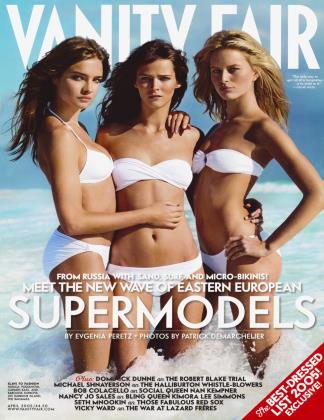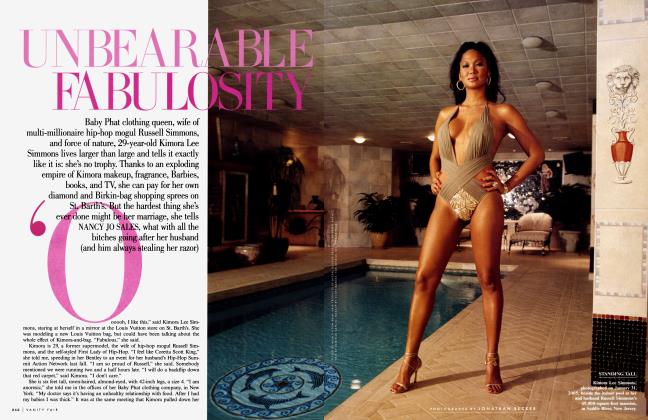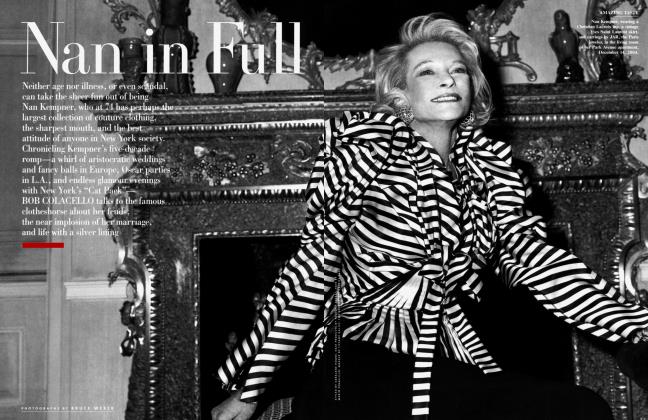Sign In to Your Account
Subscribers have complete access to the archive.
Sign In Not a Subscriber?Join NowCONTRIBUTORS
Along with Graydon Carter, Amy Fine Collins, and Reinaldo Herrera, senior articles editor AIMÉE BELL inherited the International Best-Dressed List from its creator, Eleanor Lambert, after she died at age 100 in 2003. Recognizing Lambert's unparalleled contribution to American fashion, Bell, who this July will have been with V.F. for 13 years, admits that continuing the legacy is a monumental task. "It's always a challenge to put together a list that holds up both in its historical context and editorially," says Bell, "but I am so pleased with this year's list—it reflects such a wide range of different fields and different ages." Further honoring the fashion icon, Bell also co-produced (with Louis Cona, Abby Field—who wrote the captions for the portfolio—and Chris Garrett) a film called Eleanor: Godmother of American Fashion, directed by Lambert's grandson, Moses Berkson.
After finding a new home at Vanity Fair two years ago, the International Best-Dressed List has continued to be "a record of contemporary fashion, society, and culture," says special correspondent AMY FINE COLLINS, herself a member of the International Best-Dressed List Hall of Fame and one of the four V.F. editors at its helm. "We're making an effort to remain true to the vision of Eleanor Lambert, which was to promote elegance, individuality, and exceptional taste."
Collins also enjoyed working on the LF-produced film Eleanor: Godmother of American Fashion—a. tribute to the woman who maintained the list for 63 years. Collins's best-selling book, The God of Driving, published by Simon & Schuster last year, was recently optioned for a Film.
Contributing editor REINALDO HERRERA, who first earned a place on the International Best-Dressed List in 1973, is proud to carry on the tradition begun by Eleanor Lambert in 1940. "This is the second year after Eleanor's death, and we're still trying to uphold the list," says Herrera, part of the Vanity Fair editorial team supervising the project (but just one of the hundreds, he points out, who cast their votes). "We're trying to keep this wonderful archive and continue it, and in some small way inspire people. Let's hope we can succeed.'
CONTINUED ON PAGE 80
CONTINUED FROM PAGE 78
For die-hard Yankee fan JOHN HUBA, this month's assignment— to photograph his team's arch-rivals, the Boston Red Sox, during the World Series—was one of the most difficult of his career. "My first reaction was; No, there is no way I can do that," he says. "But I bit my Yankee tongue and did the best I could." Huba left New York and headed to Fenway Park for his first sports assignment, where he discovered he was the only one shooting without a high-speed digital camera. The result is a unique, aesthetic perspective on the Sox' emotional and historic win. "I felt a bit traitorous," Huba says, "walking past Johnny Damon and Pedro Martinez—it was pretty surreal."
For the past seven years, contributing photo producer RON BEINNER has traveled the globe for V.F.— from remote African villages for the World Music portfolio to European castles for the Royals portfolio. But his latest adventure, with Patrick Demarchelier and Sarajane Hoare, will be hard to top. The crew flew down to Harbour Island, in the Bahamas, with nine stunning Russian and Eastern European models for this month's cover shoot. "In just over two hours we arrived in this amazing paradise, trading our overcoats for swimsuits," Beinner says. "It was like a scene out of a James Bond movie." Also for this issue, Beinner arranged all of the portraits for the Best-Dressed portfolio. "It was a great pleasure to work with such inspired and inspiring subjects and photographers."
Coordinating the shots for the Best-Dressed List (page 205), the models cover, and the Nan Kempner piece (page 254) presented a refreshing challenge for contributing stylist SARAJANE HOARE. All of her subjects were so effortlessly stylish that "each shoot was a delicate dance—I had to sense when to join in and when to pull back." Why, for instance, wipe the Iraqi dust off of Anderson Cooper's Prada boots, she asks, or interfere with the natural beauty of the Eastern European models? Hoare was especially delighted to work with that embodiment of class Nan Kempner: "I'd always seen her from afar, but I never dared to introduce myself." Equally shy, Hoare recalls, was Kempner's husband.
"We found him hiding in the loo!"
CONTINUED ON PAGE 82
CONTINUED EROM PAGE 80
As the fervor around the Boston Red Sox began to grow last September, SETH MNOOKIN, who grew up in Newton, Massachusetts, proposed that he follow the team for V.F. But he was afraid that he wouldn't have much of a story when, midway through the American League Championship Series, it looked as if the Sox were going to get spanked yet again by the Yankees. He had nothing to fear. Ever the true Red Sox fan, Mnookin, who superstitiously wore the same shirt throughout the playoffs, found watching even the replays of the games nerve-racking. "I kept waiting for something to go wrong," he admits. "I've seen Game Four [of the A.L.C.S.] a half-dozen times and I still can't stop pacing." This is Mnookin's first story for the magazine as a contributing editor.
For contributing editor NANCY JO SALES, the best part about hanging out in St. Barth's with the self-anointed First Lady of Hip-hop, Kimora Lee Simmons, was watching Simmons get ready to go out. "She has a cadre of three to six people around her, called her 'Glam Squad,' " says Sales of the stylists, hairdressers, publicists, and assistants who primp and perfect the Queen of Bling "as if she were a life-size Barbie doll." Although Simmons is a multi-millionaire, Sales says that the comments exchanged among Simmons and the Glam Squad during her two-hour dressing rituals—from "That dress looks like Miss Havisham" and "It looks like a tablecloth" to "She looks like Diahann Carroll" and "You don't want to smash the boobs"—were priceless.
Boardroom battles are familiar territory for contributing editor VICKY WARD. Previously for V.F., she has covered the struggles at Hewlett-Packard (June 2002), Vivendi (October 2002), and the auction house Phillips, de Pury (November 2003), among others, and this month she writes about the feud at Lazard Freres— one of the most distinguished banking houses in the world—between its C.E.O., Bruce Wasserstein, who is attempting to take the bank public, and its chairman, Michel David-Weill. "This is a story about power, ambition, the ending of one era, the beginning of another, and the gigantic clash of egos and cultures as two men, who may have more in common than they realize, wrestle with the future of Lazard," says Ward. "In the end, Lazard's fate will likely, and fittingly, be decided by the market."
CONTINUED ON PAGE 84
CONTINUED FROM PAGE 82
Contributing photographer BRUCE WEBER was more than happy to photograph two women from New York's upper echelon in the same day: 74-year-old Nan Kempner and 51-year-old Alba Clemente. The story on Kempner delves into the life of one of fashion's and society's most prominent figures. Clemente, the wife and muse of artist Francesco Clemente, was named to this year's International Best-Dressed List. "What a perfect way to spend a day—downtown with Alba Clemente and uptown with Nan Kempner," Weber says. "The two ladies couldn't be more different, but they have one thing in common—a big heart."
Fans of syndicated columnist LIZ SMITH, known for her celebrity scoops, may be surprised by the title of her latest book, Dishing: Great Dish—and Dishes— from Americas Most Beloved Gossip Columnist, an excerpt of which begins on page 170. While the tabloid tattler appears to know food, Smith insists she is more of a dinner-party guest than a gourmet chef. "It's a great thing to write this book as a person who was contemplating turning her kitchen into a closet," she says. Smith, shown here at Osteria del Circo in New York, considers Dishing, available from Simon & Schuster this month, an extension of her memoir, Natural Blonde, which was published by Hyperion in 2000.
When LIZ RICHARDSON decided to enter the Vanity Fair Essay Contest, the faint prospect of winning a prize was much less a motivating factor than her desire to record her musings as a Peace Corps volunteer in Togo, West Africa. "I love my village," she says, "but sometimes the development system seems to be less about development than about keeping Western experts in a job." Richardson, who graduated from Wake Forest University in 2003 with a degree in anthropology and French, will return to the U.S. at the end of this year, but she says there is still much that she'd like to accomplish before leaving Togo. "I'm trying to construct a health center in a remote village, fill the village pharmacy, and create a pre-school." (Her essay appears on page 158.)
HOLLY BRUBACH, whose most recent piece for V.F. was about New York State attorney general Eliot Spitzer, this month profiles the award-winning English author Ian McEwan, whose latest work could be called autobiographical—at least in terms of its setting. "Unlike many novelists, McEwan doesn't continually fictionalize his own past," she says. "But for his new book, Saturday, the protagonist's house and his neighborhood are McEwan's own. Yet the character who lives there isn't a novelist, he's a neurosurgeon." Brubach, who is working on a collection of short stories, says, "McEwan is quite a private person, and I think his setting this book where he himself lives is a way of celebrating his life at the moment—he seems so content."
 View Full Issue
View Full Issue






Subscribers have complete access to the archive.
Sign In Not a Subscriber?Join Now